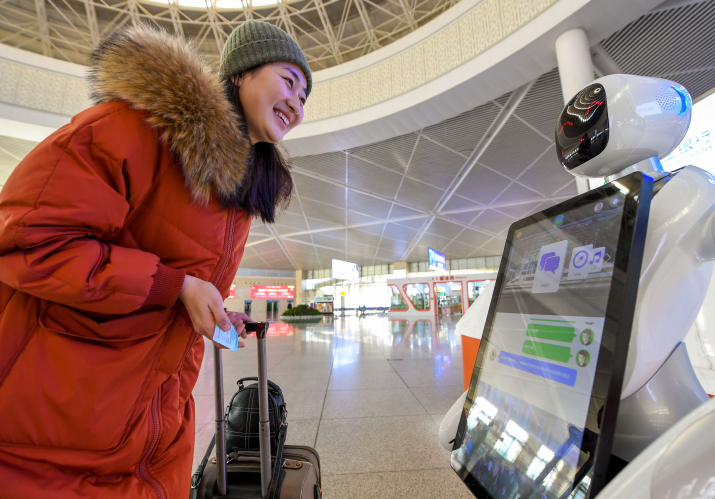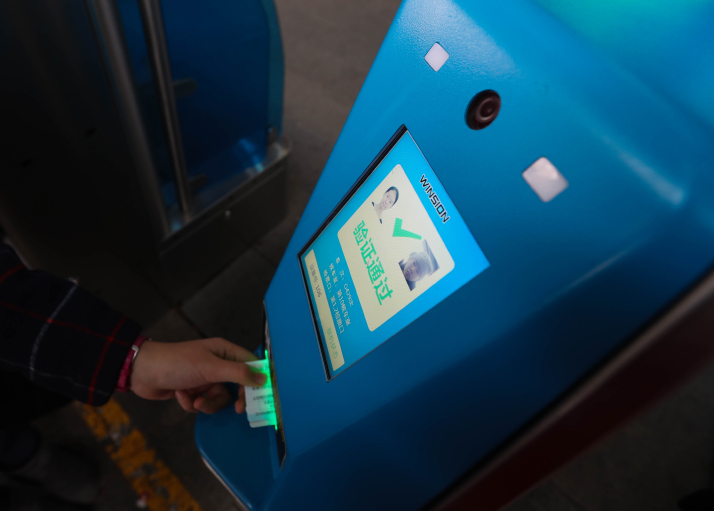|
||||||||||
| Home Nation World Business Opinion Lifestyle ChinAfrica Multimedia Columnists Documents Special Reports |
|
||||||||||
| Home Nation World Business Opinion Lifestyle ChinAfrica Multimedia Columnists Documents Special Reports |
| ChinAfrica |
| Crushing the Rush |
| Hi-tech helps make the Spring Festival rail travel rush a more pleasant experience |
| By Xia Yuanyuan | VOL.11 March ·2019-03-07 |

China's annual Spring Festival travel rush, or Chunyun, is one of the world's biggest human migrations, and brings with it a huge challenge for the country's transport system. Literally, hundreds of millions of Chinese people return to their hometowns across the country at this time of year to reunite with their families.
This year, the total passengers during the 40-day Spring Festival travel from January 21 to March 1 is expected to reach 2.98 billion, nearly 30 times more than in 1979, according to the State Council Information Office of China.
However, despite the large movement of people, technological development is providing innovative ways to streamline the process and make the travel experience as pleasant as possible. Facial recognition, artificial intelligence and smart robots are just some of the ways technology is being used by the railway authorities to provide "smart" services for travelers. In addition, the expansion of China's high-speed railway network in recent years has gone a long way to make the millions of journeys home less stressful.
Internet changes traveling
For Huang Jinyu, a 35-year-old Internet engineer working in Beijing, going back to his hometown of Qingdao in east China's Shandong Province during Spring Festival was a headache.
"Though I was eager to go back home to reunite with my family in the past, I always felt stressed out when thinking about the chunyun," Huang told ChinAfrica. "It was a major struggle."
Huang still has visions of queuing for hours to buy tickets at the railway station and even having to queue overnight.
But times have changed. Passengers can book tickets via telephone hotlines or buy e-tickets through the official website 12306.cn operated by China Railway Corp. According to data released by the company, among the 2.97 billion trips made during the Chunyun last year, over 70 percent of train tickets were sold online.
"Now, I can buy tickets online from the comfort of my home within two or three minutes," said Huang.
Every year, in the days leading up to the Spring Festival, 12306.cn is one of world's busiest websites as millions of people scramble for tickets.
During this year's chunyun, according to Zhu Jiansheng, deputy chief of the Institute of Computing Technology under the China Academy of Railway Sciences Corp. Ltd., the average daily page views of the 12306.cn ticket-booking website was 55.67 billion. At peak times, the number surged to 81.34 billion, with the highest page views at 6 billion per hour. Each day, 15 million tickets were sold by the website.
Thanks to the support of the Internet, food services of the railway sector have also been improved. Since 2017, instead of buying food on the train as the only option, passengers have been able to order food from station restaurants.
"I could order whatever I like before I arrive at the station on the 12306 phone app, and the food will be delivered to my train seat as soon as the train pulls into the station," Huang told ChinAfrica. "This is a people-centered service for passengers."
According to China Railway Corp., from the beginning of 2018, the minimum order time has been halved to an hour before delivery, and the meal options have been diversified.

Please pass through
Waiting in long queues for ticket-checking were painful memories for every Chinese traveler in the past. Passengers needed to factor in at least an hour for ticket checking into their schedule. However, today, smart facial recognition technology is helping to improve the efficiency.
At Beijing West Railway Station, standing before a ticket checking machine, passenger Ma Ying simply inserts her ticket, along with her second-generation ID card into a machine, and faces the camera for a few seconds waiting for all the information to be verified. Once the gate opens, she retrieves her ticket and ID and proceeds to the train.
"The system is miraculous as it is so smart and saves time," said Ma.
According to Fu Zheng, Deputy Director of Passenger Transport Department of the Beijing West Railway Station, the application of this technology means it takes only five seconds for each passenger to check in. About 140,000 to 180,000 passengers have used the self-service check-in system since facial recognition technology was rolled out at the station at the end of November 2018. Such technology is also being used in other railway stations around cities in China.
In the past, passengers had to visit the information desks at stations if they had any queries. However, now at Guangdong Railway Station, a smart robot has become a popular helper.
At the station entrance, the robot moves back and forth to provide passengers with information pertaining to train schedules, tickets and directions. The robot even sings and dances, if asked to do so by a passenger.
High-speed journey
"I really enjoy the smooth journey and comfort on high-speed trains and reach my hometown in several hours instead of days," Jiang Wei told ChinAfrica. He previously needed one and a half days to get home from Beijing to his hometown Xiamen City in southeast China's Fujian Province, riding in the well-known green train that traveled at a snail's pace. "It had so many stops, and I was completely worn out on such a long journey," he said.
In 40 years since China's reform and opening up, the operational speed of Chinese railways has surged from less than 40 km per hour to up to 350 km per hour. From Beijing to Shanghai, as distance of 1,300 km, a 24-hour journey in the past now takes just four hours.
Due to the rapid development of the high-speed rail network, the green slow trains have mostly been phased out from the Spring Festival rush and the high-speed railway network provides the bulk of passenger transport.
This year, in addition to the 3,819 trains in regular operation every day, an additional 1,152 and 1,330 trains were scheduled before and after the Spring Festival respectively to cope with the significant surge in the number of passengers going to and returning from their destinations, according to China Railway Corp. High-speed trains will make up 43 percent of these additional train services, up from 36 percent last year.
(Comments to xyy@chinafrica.cn)
|
||||||||||||
| About Us | Contact Us | Advertise with Us | Subscribe |
| Copyright Beijing Review All rights reserved 京ICP备08005356号-5 京公网安备110102005860号 |